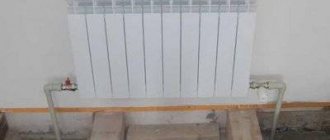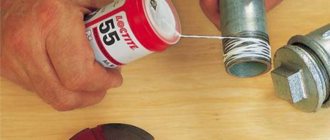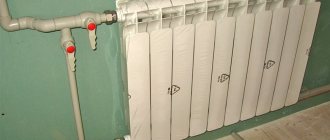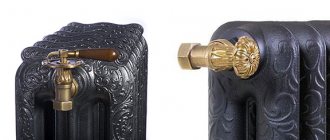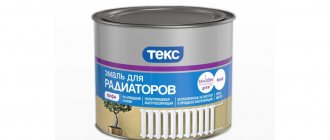How to seal connections in heating and water supply pipelines
On sale you can find many different materials that are designed to seal pipeline joints.
The question arises: which material should be used in which cases? And also, how to properly use this or that seal? It is often possible to use two or more thread sealants at once; then clarification is required as to which to prefer. The recommendations given should help to understand these issues and find a solution that will ensure sufficient reliability of the connection of pipes and threaded fittings for the entire period of operation.
Linen winding
Flax is a cheap material for threaded joints that creates a very high-quality seal. The only thing is that it cannot be used in all cases.
It is intended for connecting metal parts, as it creates significant density. It is very durable; the force applied by the keys to the two parts being connected is required to be significant.
Therefore, flax is not compacted:
- plastic parts - the tightening torque exceeds the strength of the material, the parts will be crushed and destroyed, at least the threads.
- parts in which a metal coupling with a thread is embedded in a plastic (polypropylene) shell, due to the danger of rotation (disconnection).
For all metal products, flax is the No. 1 material for winding threaded joints.
Next, let's look at how to apply it correctly.
Flax cannot be used “dry”; it must be lubricated with a special plumbing paste. It is applied either directly to the thread or to wound flax.
People's experience also suggests that sunflower oil can be used instead of paste, but the quality of the joint does not decrease, at least there is no such information.
A strand is separated from the flax and wound along a thread along each stream. Winding is done tightly and neatly. There should be no protruding hairs. The first two turns are not filled, but a shoulder is made at the end of the thread.
Special plumbing thread
A special thread for seals, of high strength (cannot be torn by hand), wound on spools, is sold in stores. Its main drawback is its high price, but otherwise it has solid advantages.
- It can be used on any parts, the tightening torque is less compared to flax, so you can also wrap plastic.
- It seals very well and can be used even on torn threads.
If it were not for the cost of this material, then only such plumbing thread would be used for joints.
Winding is carried out in exactly the same way as with flax - the first two turns of the thread are left empty so that the parts can be joined, and then winding is carried out along each thread of the thread, at the end of the winding - a double layer, i.e. shoulder
Fum tape is not suitable for creating reliable connections on pipelines. The material is not very durable; there is no sufficient density in the threaded connections of metal products with it. But for plastic connections that will be dismantled, for example, a summer pipeline for irrigation, fum tape is the most suitable sealant.
With fum tape, the parts to be joined can be wrapped by hand. In this case, a small density of the joint along the thread occurs, so that leaks do not occur for some time. A slight tightening force does not provide sufficient tightness and does not guarantee that the joint will not leak. For fixed connections, especially if they will be inaccessible during operation, it is recommended to use other materials.
Heating in the house can be done independently - the main installation issues
If the connection to the fum tape, which is already in operation, is turned, a leak will most likely occur. This is a serious drawback, considering that rotation does not require much effort.
At the household level, fum tape can be used (and is popular due to its low cost, ease of use, and low effort) for connections that are in plain sight - when connecting showers, taps, etc. Which heating scheme is best to use in a private house?
Plumbing adhesive sealant for threaded connections
The material is special, not exactly cheap, seals well, no cases of leakage have been recorded after its correct use. But only after the wrong...
The obvious disadvantage of sealant adhesive is that the quality of the joint will depend on the “human factor” more than with windings. The fact is that glue does not work well on oily surfaces.
Where do greasy surfaces come from? It could simply be carelessness - they dropped oil on the thread or rubbed the part in oil with their hands. Parts can be stored in a lubricated state (primarily steel ones). But the main thing is that a lubricant is used when cutting threads. After such an operation on steel parts, glue and sealant are completely unsuitable.
Please note that there are glue samples with which undocking the pipes requires heating of more than 100 degrees. Such heating is often difficult, not safe, plastic can be damaged, etc. Therefore, the adhesive-sealant is still selected according to the circumstances.
The glue is easy to apply. It is applied only immediately before joining, squeezed out of the tube onto the thread and smeared with your finger over the entire thread without skipping.
In what cases should you choose glue?
- When connecting plastic parts to metal ones, glue will be preferable. But such a connection does not occur often.
- The second case is when access to the docking site will be difficult. It is better to place such a connection with glue, and lubrication is carried out generously, without saving, on both parts being joined.
Winding Features
Winding on threads requires great care. The thread must be filled in an even layer without gaps, and there must be sealing material in each groove. It is laid to the end of the thread, where a shoulder is formed from it.
The main tightening of threaded connections occurs on the last two threads. On parts, more often than not, the last two turns of the thread are not cut to the full depth. Therefore, in this place the material is wedged between the two parts very tightly.
It would be nice if, when carrying out work, you organize additional (cross-cut) quality control of the flax winding. This is especially true when several dozen similar connections are performed at once.
- For those who are constantly engaged in installation, it is recommended to always have flax, plumbing thread and adhesive sealant with you in order to quickly and efficiently complete any connection. It is recommended to apply all this in accordance with the tips given above.
- When doing work at home with your own hands, when doing something simple and in plain sight, you can use cheap fum tape, but you need to wrap more. When installing entire systems with your own hands, it is better to use flax (with vegetable oil) on metal, and for small volumes of work it is even better to use thread. Maximum attention should be paid to the quality of winding on the thread.
What should never be used to seal threaded connections:
- There is no need to use simple silicone; it is designed for flange connections.
- There is no need to use paints, whitewash, or red lead, which are of little use, but make the connections semi-dismountable - this is long outdated.
How to seal threads in heating systems?
When installing a new autonomous heating system or a traditional heating system in a country house, changing batteries or resealing threaded connections before the start of the heating season, spend a couple of minutes of your attention on what materials the specialist will use in his work.
Why is it important?
The choice of material for sealing threads becomes critically important if the heating system of a country house requires the use of antifreeze based on aqueous solutions of glycols (ethylene glycol, propylene glycol). Substances that are excellent solvents in their pure form are greatly diluted with water, but at the same time they do not lose too much of their aggressive effect on sealing materials. An ideal option would be to use fum tape, which is resistant to almost all aggressive substances known in the world, however, in addition to the effects of solvents, the heating system of a country house is subject to heating-cooling cycles, during which it experiences varying loads caused by the thermal expansion of the pipe material.
By the way, the coefficient of thermal expansion of polypropylene is several times higher than that of steel pipes, and in such systems the consequences are more pronounced.
Connections of autonomous heating systems of a country house assembled on FUM tape in such conditions usually lose their tightness quite quickly, so when sealing heating pipes, master installers have to return to the tape.
And here unexpected and very unpleasant surprises can await the homeowner. The fact is that there is no adequate paste combined with flax for such an environment. As a rule, several options are used - one is worse than the other.
Sealing the threads of autonomous heating systems of country houses on a dry strand - without sealant. Let us immediately note that compaction using this method is quite labor-intensive. Penetrating glycols easily pass through the smallest pores. Replacing such a seal may be necessary quite soon, fortunately, leaks are not severe - flax does not have time to decompose and in most cases they (leaks) are light drops.
Flax and flax paste (as an option - flax and paint, flax and silicone sealant). Glycols seem to be created to dissolve the main components of such pastes - in particular, rosin, which forms the basis of the most famous paste on this market. Interaction with silicone-based pastes and impregnations in the presence of high temperatures can in practice lead to leaks, although in theory these substances are conditionally resistant to each other.
Alternative?
That is why the latest generation of sealing technologies - in particular, anaerobic gels that guarantee reliable connections in autonomous heating systems of a country house - are becoming increasingly widespread. The anaerobic gel polymerizes (without shrinking or expanding) in the joint upon contact with metal after filling the threaded gap. After polymerization, the resulting plastic is chemically resistant to a large number of types of aggressive and technical liquids: gasoline, alcohol, oils, including glycol-based antifreezes for heating systems. The connection will last as long as your pipes, and you can forget about leaks and replacing seals in heating systems.
The main thing.
There can be a lot of threaded connections in a modern cottage. And if you don’t know the recipe, they can also cause considerable frustration. Someone, and usually this role is played by a conservative master, may say that modern products for sealing threads in autonomous heating systems are very expensive.
In fact, the cost of one package of any of the products mentioned above does not exceed the cost of a cup of coffee (200-300 rubles).
We will not dwell on whether it is expensive or cheap for the owner of a country house. Most likely, behind this argument lies both the fear of learning something new and the fear that installation using a new technology may not be successful.
The very detailed instructions located on the back of the packaging of each gel will help you get started with installing an autonomous heating system for a country house using new technology. In addition, the following article will help increase your understanding of the principles of operation of the composition.
How to seal threaded connections?
Heating system in a country house. Antifreeze is used as a coolant. What is the best way to seal threaded joints - flax or a special thread, which many market sellers recommend for use in heating systems. Besides, if it’s linen, how good is it to coat it with paste (there’s plenty of it in the markets too, I don’t remember the name off the top of my head. I used to paint it the old fashioned way and it’s done. Is paste better?
The pressure is low, the thread is of high quality and with notches - both the thread will work and flax with paste.
No paint, it will leak. Linen + silicone sealant and you will be happy
2Saska Fum is more reliable because it doesn’t react with anything at all, but you need experience.
DOKA wrote: 2Saska. but you need experience.
And a lot, a lot of fum tape. Gee.
What kind of silicone sealant? Is this exactly the paste that is found in plumbing stalls at markets?
I collected it on a transparent one (like orderlies). You wrap it with flax, with your finger on top
you coat it with sealant and off you go. I’ve never heard of paste, but why would you need it when there is silicone sealant, which obviously matches the characteristics. I frankly don’t recommend it, but its supporters will forgive me. I suffered with it. With flax and sealant (paste) it certainly won’t ooze anywhere on the thread.
Use a specialized product for heating systems that is known to be temperature, pressure and compatible with metals and coolant.
During the construction of my house, my plumbers installed connections on flax and paint. It didn’t leak anywhere, but in order to dismantle the meters and taps after 2 years (I was making a new water supply system), I had to cut out a piece of pipe with all the equipment, take it to the garage and disassemble it in a vice. On a polypropylene pipe, it turned out to be almost impossible to disassemble such a connection - everything was so stuck together from the paint. Now I just installed it on flax - I was afraid that I wouldn’t be able to unscrew the valves from the pipe later (for repairs, replacement, etc.). It’s not leaking anywhere yet, but the question arose: won’t flax rot over time from water? Maybe redo it and plant it on pasta with flax?
Seal the thread using FUM tape.
The abbreviation FUM stands for fluoroplastic sealing material.
FUM can withstand temperatures from -200º C to 240º C and pressure up to 30 atmospheres.
Therefore, it can be used both in heating systems and water supply networks.
FUM is suitable for non-freezing coolants and other aggressive environments.
To seal the threads on gas pipes, a special gas FUM tape is used (it is thicker than water tape).
This method of sealing is very simple; personally, I prefer to seal the thread with FUM tape, but this is a matter of skill and taste.
I bring to your attention the following video on this issue:
Main types of pipe seals
From the entire arsenal, the following can be distinguished:
The question “which pipe sealant is better and which is worse?” - incorrect. In order to understand this question, it needs to be posed somewhat differently: “What type of sealing of threaded connections should be used in specific conditions?”
Let's start with what sealant should not be used for threaded connections:
- Silicone (good for flange connections);
- Ship's red lead;
- Whitewash, various types of paints.
So, there are 4 types of material left:
Seal flax
Flax for winding threaded connections
You can use flax as a winding for pipes on all metal parts: brass, cast iron, steel. With limitations, flax can be used where metal threads are soldered into plastic threads. A bad option would be to use linen on completely plastic parts. When sealing threaded connections where the sealant is flax, a large tightening torque is required. This moment can sometimes exceed the capabilities of plastic parts, which is why it is possible to break the thread itself.
Linen
Sealing threaded joints using flax thread is one of the oldest and most proven methods. Linen is sold in any plumbing store and markets.
When purchasing, be sure to pay attention to the following signs:
- elasticity of the thread;
- absence of garbage, unpleasant odor;
- small thickness of strands.
Linen in its pure form begins to quickly rot upon contact with water, with temperature changes, and in heating systems it completely burns out. In addition, the material does not help prevent rusting of metal pipes and fittings, unlike more modern sealants.
To level out these shortcomings, the thread is impregnated with special compounds (pastes). Thickly grated natural red lead is often used. The cheapest option is to make the paste yourself by taking whitewash and adding drying oil until you get a mass like sour cream. It is applied to the linen thread in a thin layer, smeared and dried.
Red lead is more suitable for working with steel pipes: it oxidizes the top layer of iron to an insoluble compound that does not allow oxygen to pass through, working like a bluing process. Stores also sell ready-made flax thread sealant pastes:
- Unipak (soap, chalk, paraffin, water, mineral oil).
- Multipak (paraffin oil with mineral additives).
- Pastum GAS (organic binders, special fillers, additives and anti-corrosion additives).
- Gebatout 2 (white mineral oil, thickener, synthetic polymer, mineral filler).
If the specified means are not at hand, for better sealing of gas connections, you can impregnate the flax with ordinary oil paint or automotive sealants.
The work is done as follows: a strand of flax 2 matches thick is separated from a common skein, wound onto the thread, starting from the far end and ending at the end of the pipe. After this, the flax is coated with paste, the joint is assembled (when twisting, force should be felt).
Plumbing thread
Sealing threads with plumbing thread
Plumbing thread is an excellent winding material for pipes with one drawback: its high price. It cannot be torn by hand and is suitable for sealing all threaded joints (even those that have a torn surface from a bad thread cutting tool). As for plastic parts, the tightening torque required when using threads is not the same as when using flax. Plumbing thread can be used for all parts.
Plumbing flax
Plumbing flax is a product of processing flax and hemp. It is a purified and combed fiber that looks like hair. It is a natural sealant.
Application of sanitary flax
It is used for sealing threads of hot and cold water supply heating and systems . Equally effective for connections made of ferrous and non-ferrous metals. It is used to seal not only threaded connections, but also, for example, to seal connections of sewer pipes , seal cracks in bathhouses, and log houses. Even for sound insulation , sanitary linen is very effective.
Characteristics of sanitary flax
Plumbing flax is divided into two grades.
Combed sanitary flax.
These are long, thin and strong fibers, purified from plant stem residues. Used to seal water pipes and gas pipelines.
Frayed sanitary linen.
This is the raw material for the production of combed sanitary flax. It has a more torn and heterogeneous structure due to the presence of a large number of chips and plant remains. It is for this reason that it is not suitable for gas pipes, but is suitable for sealing all other connections.
Advantages of sanitary flax
- Durability.
- Low cost.
- Can be used for any diameter . Greatest efficiency on large diameters.
- No preliminary thread preparation .
- Possibility to adjust the position without breaking the seal.
- Possibility of use in heating systems .
- It has the ability to expand as it absorbs moisture.
Disadvantages of sanitary flax
- Not effective without special plumbing paste .
- Due to the use of paste, your hands and the area around the thread get dirty.
- Requires precise adherence to turns.
- To work with tow, experience is required .
- Due to its biological origin, it does not very long service life , about 5 years.
How to wind plumbing flax
First you need to lightly coat the thread with plumbing paste, then you need to separate strand of flax tow from the general bundle straighten the fibers across the width. Winding should be clockwise for right-hand threads . Upon completion of winding, the excess should be cut off, and the laid seal should be coated well with paste.
How much flax to wind on the thread
You should wind so much that the material completely covers the entire thread for at least 2 - 3 turns . It all depends on the thickness of the chosen strand, and may differ from one time to another.
Manufacturers of sanitary flax
- Russia PREMIUM . Quite a popular manufacturer of sanitary linen.
- Europe VALTEC . One of the best manufacturers of thread seals.
- China Chinese sanitary linen for some reason without a name.
Anaerobic sealant
Anaerobic sealant is certainly suitable for sealing all plastic threaded connections, for brass, for cast iron, factory-made, but there is one peculiarity on steel parts.
When threads are made in a steel part, various types of lubricants are used that get onto the threads. When applying glue, once it hits a greasy area, it lingers there. This may not be noticed. Once the coupling begins to be turned, a channel may form through which the liquid will then flow out.
It is not always possible on site to remove grease from the surface of the thread. Therefore, it is not recommended to use glue-sealant as a sealant for steel threads and parts, since there is flax and thread.
When using sealant, pay attention to what kind of adhesive sealant you got. Some grades require heating when disassembling the joint. Imagine a metal connection with a metal coupling followed by a plastic pipe. To disassemble it, you must first heat it up (obviously more than 100 degrees). For the metal part this does not matter, but the plastic pipe may later be damaged. Therefore, look at what type of threaded connections you seal with sealant!
eFum tape does not inspire confidence as a sealant for pipes. But the tape can be used in a summer cottage or in a vegetable garden, since there is nothing to worry about if something leaks.
How to seal threads in heating systems. How to seal heating system connections
One of the most important requirements for a heating system is the absence of leaks. Only the absence of coolant losses can guarantee stable and economical operation of the equipment. Therefore, when installing and repairing heating, special attention is paid to ensuring the sealing of joints and connections.
One of the most commonly used methods of joining parts of heating networks is a threaded connection. Let's consider the materials and methods by which their sealing is ensured.
Sealing with end gaskets
The most technologically advanced and fastest method for assembly, which, however, is rarely used for heating systems.
With this method, a part with an external thread during assembly compresses the gasket located at the narrowing of the mating part. To ensure a tight joint, simply install a gasket (paronite, fluoroplastic, rubber) and screw the parts until they stop. However, this method requires precise processing of the profile of the internal thread part, and it is difficult to ensure a transition without narrowing. Therefore, a similar method of sealing threaded connections is more often used for the installation of measuring instruments and sensors, where an increase in hydraulic resistance is not important. It can also be noted that even in this case, experienced locksmiths still additionally use sealant.
Sealing using FUM tape
In this case, fluoroplastic tape is used. This method allows you to quickly assemble threaded connections and reduces the screwing force (due to the low coefficient of friction of the fluoroplastic). Another advantage is high chemical resistance and durability.
Sealing of threaded connections with FUM tape
But it also has some disadvantages:
- when assembling connections with very smooth or rough threads, the tape may tear or be squeezed out;
- not suitable for joints that are subject to thermal deformation, since the tape does not have adhesion to materials and can be squeezed out when the joint is “played” (of course, you can additionally use a sealant, but then the question arises: why use the tape);
- does not provide a reliable seal for threaded connections with a diameter of more than 25 mm (not suitable for assembling radiators of a heating system).
Sealing thread
It is also made of Teflon (fluoroplastic) or nylon; sealing with it has all the same advantages as sealing threaded connections with FUM tape and the same disadvantages, with the exception of the tendency to extrusion or rupture. Also unsuitable for assembling radiators for heating systems.
Sometimes a thread is produced for impregnation with a non-drying sealant, which improves its adhesion.
Linen span
The most famous and used sealant for quite a long time. Used in conjunction with impregnation with oil paint or red lead. Although there are more modern materials, flax span is still the most common material for assembling threaded connections of heating system radiators. But it still has many disadvantages:
- Requires a certain skill for proper winding and coating;
- Has limited durability;
- Prone to drying out.
As an option that improves the quality of this sealing method, liquid or paste silicone sealant is used for impregnation.
Drying and non-drying liquid and paste sealants
Most often they are made from silicone. They have sufficient heat resistance for assembling batteries and other elements of the heating system. They simplify the assembly of threaded connections due to their lubricating effect. If you use a non-drying sealant, then the parts of the heating system will be easy to disassemble. The disadvantages include the fact that non-drying pastes can be squeezed out under high system pressure. Curing sealant may shrink and the joint may leak over time.
How to seal a joint with flax?
When sealing threaded connections, you need to be very careful. Accuracy is the key to ensuring that nothing leaks. When working, you will need a special paste, which you cannot do without. It can be applied to the thread immediately or to already wound flax.
Paste gets your hands dirty. It's not very pleasant to wipe them off. Therefore, there is a life hack - the installer first sits down, winds flax onto a threaded connection, checks the quality of the winding (everything should be smooth) and then uses the paste, making a dozen connections at once. The connection must be free of protruding hairs, the first two turns remain free so that you can safely screw the coupling onto the external thread. And towards the end of the thread a roller or thickening is formed.
All compaction occurs on the last two threads. They are not completely cut through, smaller than the other turns. They are sealed by gluing the sealing material between the two parts.
How to apply adhesive sealant?
It is impossible to apply sealant to many joints at once, as with flax. The glue is applied to the thread immediately before the “sausage” connection, which is then well spread over the entire thread. This is necessary to prevent empty spaces from appearing through which water can then seep through.
The threads should be checked after sealing the connection. Therefore, sealant is used quite rarely, in the most necessary cases. For example, when you need to connect a plastic part with a metal one, you can’t think of anything better than glue.
The manufacturer recommends applying sealant to only one part, but experience says otherwise. If you are sealing a threaded connection that will be difficult to get to, then apply the glue well with your finger to the coupling and threads so that there are no unpainted areas anywhere. It has a blue or red color, it is clearly visible. It is necessary that all the streams are filled and then the parts can be connected. For steel parts, it is better not to use glue as a sealant for pipes.
Sealing thread
If my memory serves me correctly, it appeared on the shelves in a plumbing store (at least in our village) 7-8 years ago, correct me in the comments if I’m wrong. It was Tangit Uni-Lock from Henkel. Everyone began to actively buy it, there was such a laudatory advertisement, everyone really liked it, but after a while people began to make repairs, change the plumbing, heating and other appliances.
We were faced with a very unpleasant problem, especially on large thread diameters; the connections were either very difficult to unscrew or simply impossible, we had to burn the thread with an acetylene torch! And all because the thread was almost not lubricated with anything, that is, the metal began to rust, since it absorbed moisture and, it seems to me, let oxygen through, because I can’t find any other explanation. The threads were just in terrible condition, I don't use it anymore. I agree that it is very convenient to pack and the connections are reliable and do not leak, although you also need to practice! I can recommend additionally lubricating it with sealant or plumbing paste.
Types of pipe seals
From the wide variety of materials intended for sealing threads, the following can be distinguished:
Many users use flax to seal threads in plumbing fixtures. This material is suitable for all metal parts: cast iron, steel, brass.
It is not recommended to use flax for plastic fittings and fittings made of metal and plastic. The thing is that sealing pipe connections with flax initially presupposes a high-quality seal. To do this, you need to apply force and tighten it well.
Plastic elements will be very difficult to tighten. It is more likely that you will be able to simply rip off the threads rather than create a tight connection with the flax gasket.
Plumbing thread
Plumbing thread is a good sealant that is of high quality and excellent strength. It can be used to seal pipe connections made of metal, plastic, metal-plastic.
Its only drawback is its high cost compared to other types of seals. Otherwise, it is a reliable sealant.
Plumbing thread Henkel Tangit Uni-lok
Adhesive sealant
The adhesive is suitable for almost any threaded connection. When working with this material, it is important to observe one condition - before applying it to the surfaces of parts, they must be thoroughly degreased.
As for products made of steel, this condition can become a serious obstacle to the use of sealant. This is due to the fact that thread cutting is usually performed directly at the installation site. To improve the performance of the tool, special lubricants are used. But it is very difficult to remove them from the surface of the metal in a working environment, and sometimes it is not possible to do this at all.
If you neglect this requirement and apply an anaerobic sealant to an oil-contaminated steel surface, you will get an unreliable connection that will deform very quickly.
Another limitation regarding the use of thread adhesive is how it is removed. The fact is that in the process of dismantling connections with sealant, it is necessary to heat the parts. This procedure is not dangerous for metal products, but products made of plastic or metal-plastic may be damaged.
It is worth saying that heating of parts during dismantling is provided only for certain types of sealant. Therefore, you need to carefully read the information provided on the product packaging.
Thus, the sealant can be used for any threaded connections, with the exception of steel products. When choosing a sealant, you need to take into account the fact that sooner or later the parts will have to be dismantled, so for plastic and metal-plastic products you should choose an adhesive whose application does not require pre-heating of the parts.
Anaerobic adhesive sealant Fixant encor
This sealing material began to be used relatively recently, compared to other sealants. Fum-tape builds - inexpensively, but it cannot boast of high strength, because... The material breaks with little effort.
According to manufacturers, fum tape is an excellent sealant, but as practice shows, the quality of connections leaves much to be desired.
When choosing a sealant for a threaded connection in an apartment or house, it is better to abandon the idea of using fum tape and give preference to more reliable sealants. For example, at a summer cottage or in a vegetable garden, fum tape can be used. There are no such stringent requirements in terms of reliability and durability.
Pros and cons of materials
Flax and pasta . The advantages of these materials include durability and tightness of the connection, if done correctly. Thread sealing with flax is used when installing plumbing and heating systems, and the maximum permissible temperature of the working environment should not exceed 90°, otherwise the seal will begin to collapse.
The disadvantages include the complexity of installation work - skill is required to properly seal the joints with flax fiber. It should also be noted that when tightening and dismantling such a connection, serious physical effort is required, which can damage the connecting elements.
Flax fiber is not suitable for sealing threaded fittings made of polymer materials - when wet, the natural material expands, as a result of which the plastic element may burst. Flax sealing is not recommended for use when installing a heating system if it is planned to use non-freezing liquid as a coolant.
FUM tape . Fluoroplastic sealing material (FUM), which is produced in the form of a tape, retains its performance properties at temperatures from -200°C to +240°C and pressure up to 30 atm, which allows the material to be used for the installation of plumbing and heating systems without restrictions. The tape seal is suitable for heating systems with antifreeze. The material protects the metal of the thread from corrosion; due to the smoothness of the tape, the connection is easily assembled and dismantled.
The disadvantage of the material is the same smoothness of the tape - under the influence of vibration and mechanical loads, the connections weaken and may begin to leak. FUM tape is not suitable for installation with positioning, especially when it comes to valves and taps.
Sealing threads . Also, to seal threaded connections, polyamide and fluoroplastic threads are used, equipped with a special lubricant, which simplifies installation and dismantling, and also prevents joints from leaking. PTFE thread has the same characteristics and scope of application as FUM tape. Thread sealing with polyamide thread is used in pipelines with ambient temperatures up to 130°C and pressures up to 16 atm.
Plumbing threads have all the advantages of a flax sealant, but at the same time they are much easier to install, do not rot, are not destroyed by temperature, and protect the metal from corrosion. The only drawback of the material is its high cost.
Paste a VALID AdSense code in Ads Elite Plugin options before activating it.
Non-drying pastes - are made on the basis of synthetic resins with oils and filler. The advantage is ease of use - to seal the joint, it is enough to lubricate the threads of both connected elements. The non-drying paste seals the joint and protects the threaded connection from corrosion, making it easy to dismantle the assembly.
The disadvantages include a narrow scope of application - the non-drying composition is suitable only for non-pressure or low-pressure systems, since under pressure it will be squeezed out. The seal is destroyed under the influence of aggressive environments, so it cannot be used for heating systems with antifreeze.
Drying pastes . Solvent sealants are suitable for use in pressurized systems. To seal the thread, the compound is applied to both parts to be joined, and the parts should be connected immediately so that the sealant does not have time to set. The drying paste effectively seals the thread.
Sealing with this type of paste is only suitable for installing connections with a small gap, otherwise when drying the material will shrink strongly and the threaded connection will leak.
Anaerobic sealant . The practically liquid composition is as simple as possible to use - it is applied to the thread and the elements are tightened.
Anaerobic sealants are divided into several types depending on the conditions of use, so when choosing, you should pay attention to the following parameters:
- Operating temperature range;
- thread diameter for which this type of seal is designed;
- force required for disassembly;
- polymerization time.
How to hermetically connect pipes with flax?
When starting to seal threaded connections, it is important to be very careful. Accuracy is the key to ensuring that there are no leaks. To work, you need to acquire a special paste, which is applied to the thread or to the already wound flax.
This paste has one obvious disadvantage: it gets dirty, and it’s quite difficult to wipe your hands off of it. In this regard, installers have the following rule: initially flax is wound on the thread, after that the quality of the winding is checked (it is important that there are no unevennesses) and after that the paste is applied. The connection must be free of protruding hairs, the first two turns remain free so that you can safely screw the coupling onto the external thread. And towards the end of the thread a certain ridge or thickening is formed.
Inch threads have a conical shape. And the entire compaction process is carried out on the last two threads. They are not completely cut through, and are smaller in size than the other turns. They are sealed, sealing material is glued between the two parts. And after that the paste is applied.
Sealing with plumbing thread
A prerequisite for applying thread is a thread with notches. If the thread is smooth, then a wrench should be used to apply notches. The thread is wound starting from the third turn. Despite the fact that it is written on the thread that you can wind it any way you like, it is best to wind it carefully, so that there are no free spaces.
After this, the thread should have free first two turns, just like in the case of flax, and a seal on the last two turns. If the procedure is performed correctly, with strict adherence to technology, the sealing of threaded connections will be reliable and will last a long time.
